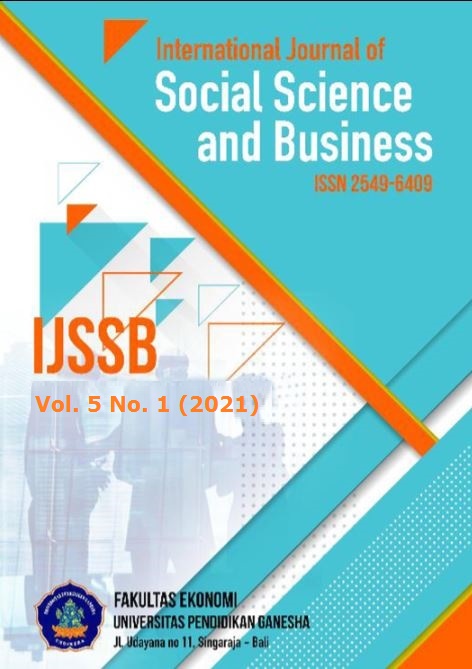Why What they Say Matters: The Impacts of Visitors’ Experiences on Tourism Sustainability
DOI:
https://doi.org/10.23887/ijssb.v5i1.31355Keywords:
Visitors’ Experience, Tourism SustainabilityAbstract
The success and failure of a destination tend to rest on its’ capacity to satisfy the visitors. Listening to visitors’ appraisal and voices is vital in community-based tourism development. This study aims to explore WPP Dalegan visitors’ voices. The data are collected through Dalegan visitors’ online reviews and direct observation. The study finds that Dalegan has a high competitive advantage as family recreational destination as it is cheap, reachable, accessible, has various local-traditional-cheap food, beautiful calm beach and soft white sand as a playing and learning ground for children. Despite its’ comfortable image, some visitors voice unsatisfied services, facilities, nature-caused and human-caused threats. The study also illuminates that Dalegan destination branding is not only influenced by its’ capacity to attract visitors by its’ beautiful marine nature, but also local community characters, community education and values. The study indicates that to develop tourism destination, local potentials are not the only determinant keys. It needs to be supported by other determining factors. One of those factors is tourists’ voices on their impression, comments, satisfaction and dissatisfaction feelings. Linking potential resources of destination and tourists’ meaningful experience can be challenging as different tourists may have different perspectives, wants and satisfaction-dissatisfaction levels.
References
Aliman, N. K., Hashim, S. M., Wahid, S. D. M., & Harudin, S. (2016). Tourists’ satisfaction with a destination: An investigation on visitors to langkawi island. British Journal of Marketing Studies, 4(5), 1–20.
Armario, E. (2008). Tourist satisfaction: An analysis of its antecedents. Universidad, Sociedad y Mercados Globales.
Aunalal, Z. I., Kadir, Abd. R., Taba, Muh. I., & Hamid, N. (2017). The Influence of Service Quality Dimensions, Destination Image and Satisfaction to Tourist Loyalty in Maluku Province. Scientific Research Journal, V(VI), 71–85.
Bagri, S. C., & Kala, D. (2015). Tourists’ satisfaction at Trijuginarayan, India: An importance-performance analysis. Advances in Hospitality and Tourism Research (AHTR) An International Journal of Akdeniz University Tourism Faculty, 3(2), 89–115.
Boit, J., & Doh, M. (2014). The role of destination attributes and visitor satisfaction on tourist repeat visit intentions: The case of lake nakuru national park, kenya. Proceeding of the 2014 Northeastern Recreation Research Symposium, 1–9. http://www.esf.edu/nerr/past/.
Buonincontri, P., Marasco, A., & Ramkissoon, H. (2017). Visitors’ Experience, Place Attachment and Sustainable Behaviour at Cultural Heritage Sites: A Conceptual Framework. Sustainability, 9(1112), 1–9. https://doi.org/10.3390/su9071112.
Byrne, B. (2012). Qualitative interviewing. In Researching society and culture (3rd ed., pp. 206–244). SAGE Publication Ltd.
Calaretu, B., & Bulin, Daniel. (2012). Environmental threats for tourism development. Calitatea, Suppl. Supplement of “Quality - Access to Success” Journal, 13(1), 79-83.
Canny, I. U. (2013). An Empirical Investigation of Service Quality, Tourist Satisfaction and Future Behavioral Intentions among Domestic Local Tourist at Borobudur Temple. International Journal of Trade, Economics and Finance, 4(2), 86–91. https://doi.org/10.7763/IJTEF.2013.V4.265.
Chavan, R., & Bhola, S. S. (2013). Assessing Tourist Infrastructure of the Satara District: The Views of Visitors. International Journal of Management Research and Business Strategy, 2(3). https://doi.org/10.2139/ssrn.2315633.
Choi, Y. (2016). Exploring factors that affect the destination brand in tourism industry [Master Thesis]. KDI School of Public Policy and Management.
Corte, V. D., Sciarelli, M., Cascella, C., & Del Gaudio, G. (2015). Customer satisfaction in tourist destination: The case of tourism offers in the city of Naples. Journal of Investment and Management, 4(1–1), 39–50. https://doi.org/10.11648/j.jim.s.2015040101.16.
Creswell, J. W. (2007). Qualitative inquiry & Research design. Choosing among five approaches (2nd ed.). SAGE Publications Inc.
do Valle, P. O., Silva, J. A., Mendes, J., & Guerreiro, M. (2006). Tourist Satisfaction and Destination Loyalty intention: A Structural and Categorical Analysis. Int. Journal of Business Science and Applied Management, 1(1), 26–44.
Dupeyras, A., & MacCallum, N. (2013). Indicators for Measuring Competitiveness in Tourism: A Guidance Document (OECD Tourism Papers 2013/02). OECD Publishing. http://dx.doi.org/10.1787/5k47t9q2t923-en.
Fernandes, T., & Cruz, M. (2016). Dimensions and outcomes of experience quality in tourism: The case of Port wine cellars. Journal of Retailing and Consumer Services, 31, 371–379.
Filosofova, T., & Apostolov, D. (2017). Effects of Tourist Satisfaction: Influence on the Touristic Flows (Case Russia-Bulgaria). International Relations. 2017 Current Issues of World Economy and Politics., 285–295.
Fitchett, J. M., Grant, B., & Hoogendoorn, G. (2016). Climate change threats to two low-lying South African coastal towns: Risks and perceptions. South African Journal of Science, 112(5/6), 1–9.
Friedrich, J., Stahl, J., Hoogendoorn, G., & Fitchett, JenniferM. (2020). Exploring Climate Change Threats to Beach Tourism Destinations: Application of the Hazard-Activity Pairs Methodology to South Africa. Weather Climate and Society. https://doi.org/10.1175/WCAS-D-19-0133.1.
Fuchs, G., & Pizam, A. (2011). Importance of Safety and Security for tourism destination. In Destination Marketing and Management. Theories and Applications (pp. 300–313). CAB International.
Gaki, E., Kostopoulou, S., Parisi, Evangelia. D., & Lagos, Dimitris. G. (2016). The evaluation of tourism satisfaction in island destinations: The case of the Ionian Islands of Greece. 56th Congress of the European Regional Science Association: “Cities & Regions: Smart, Sustainable, Inclusive?”, 23-26 August 2016, Vienna, Austria. http://hdl.handle.net/10419/174645.
Ghaderi, Z., Saboori, B., & Khoshkam, M. (2017). Does security matter in tourism demand? Current Issues in Tourism, 20(6), 552–565. https://doi.org/10.1080/13683500.2016.1161603.
Gnanapala, W. K. A. (2015). Tourists Perception and Satisfaction: Implications for Destination Management. American Journal of Marketing Research, 1(1), 7–19.
Hasan, S. A., Subhani, M. I., & Osman, A. (2012). Effect of Trust Factors on Consumer’s Acceptance of Word of Mouth Recommendation. European Journal of Social Science.
Jeuring, J., & Haartsen, T. (2017). Destination branding by residents: The role of perceived responsibility in positive and negative word-of-mouth. Tourism Planning & Development, 14(2), 240–259.
Khuong, M. N., & Nguyen, P. A. (2017). Factors Affecting Tourist Destination Satisfaction and Return Intention – A Study in Ho Chi Minh City, Vietnam. Journal of Economics, Business and Management, 5(2), 95–102. https://doi.org/10.18178/joebm.2017.5.2.493.
Kordić, N., Živković, R., Stanković, J., & Gajić, J. (2015). Safety and security as factors of tourism destination competitiveness. Key Issues on Tourism Destination Competitiveness. Sitcon. https://doi.org/DOI: 10.15308/sitcon-2015-34-38.
Kôvári, I., & Zimányi, K. (2011). Safety and security in the age of global tourism (The changing role and conception of Safety and Security in Tourism) (Applied Studies in Agribusiness and Commerce, pp. 59–62) [Scientific Paper]. http://ageconsearch.umn.edu/record/104672/files/10_Kovari_Safety_Apstract.pdf.
Lai, I. K. W., Hitchcock, M., Lu, D., & Liu, Y. (2014). The Influence of Word of Mouth on Tourism Destination Choice: Tourist–Resident Relationship and Safety Perception among Mainland Chinese Tourists Visiting Macau. Sustainability, 10. https://doi.org/10.3390/su10072114.
Mahlangu, M. M., & Fitchett, J. M. (2009). Climate change threats to a floral wedding: Threats of shifting phenology to the emerging South African wedding industry. Bulletin of Geography. Socio-Economic Series, 45, 7–23.
Maruthaiah, S., & Rashid, R. A. (2014). A Review of Visitors Satisfaction and Perception of Crowding. 63–68. http://dx.doi.org/10.15242/ICEHM.ED0314529.
Mikić, A., Bovan, A., & Jokić, D. (2017). Branding of tourist destination as an important strategic resource of economic development. 9–59.
Naidoo, P., Ramseook-Munhurrun, P., & Seegoolam, P. (2011). An Assessment of Visitor Satisfaction with Nature-Based T ourism Attractions. International Journal of Management and Marketing Research, 4(1), 87–98.
Nugraha, K. S. W. (2019). Experiential Marketing: Managing Tourist Satisfaction And Revisit Intention Bangsring Underwater Banyuwangi. International Journal of Scientific & Technology Research, 8(11), 3475–3479.
Owiyo, V., & Mulwa, J. M. (2018). Safety and Security in Tourism Destinations: Its moderating role in the Destination Competitiveness Determinants and Destination Competitiveness Nexus in Western Kenya Circuit. International Journal of Research in Management & Business Studies, 5(3), 30–33.
Peeters, P., Gössling, S., Klijs, J., Milano, C., Novelli, M., Dijkmans, C., Eijgelaar, E., Hartman, S., Heslinga, J., Isaac, R., Mitas, O., Moretti, S., Nawijn, J., Papp, B., & Postma, A. (2018). Research for TRAN Committee -Overtourism: Impact and possible policy responses (pp. 7–254). European Union. http://www.europarl.europa.eu/thinktank/en/document.html?reference=IPOL_STU(2018)629184.
Pereira, L. A., Limberger, P. F., Flores, L. C. da S., & Pereira, M. de L. (2019). An Empirical Investigation of Destination Branding: The Case of the City of Rio de Janeiro, Brazil. Sustainability, 11(90), 1–17. https://doi.org/10.3390/su11010090.
Prayag, G. (2011). Paradise for Who? Segmenting Visitors’ Satisfaction with Cognitive Image and Predicting Behavioural Loyalty. International Journal of Tourism Research. https://doi.org/10.1002/jtr.
Radović, V., & Arabska, E. (2016). Why should security aspects be more seriously considered in development of serbian tourism industry? Pregledni Članak, 71–80. https://doi.org/10.5937/timsact10-8127.
Rajesh, R. (2013). Impact of Tourist Perceptions, Destination Image and Tourist Satisfaction on Destination Loyalty: A Conceptual Mode. Revista de Turismo y Patrimonio Cultural, 11(3), 67–78.
Ronizi, S. R. A., Roshan, GH. R., & Negahban, S. (2016). Assessment of Tourism Climate Opportunities and Threats for Villages Located in the Northern Coasts of Iran. Int. J. Environ. Res, 10(4), 601–612.
Seyfi, S., Hall, C. M., & Rasoolimanesh, S. M. (2019). Exploring Memorable Cultural Tourism Experiences. Journal of Heritage T Ourism, 1–24. https://doi.org/10.1080/1743873X.2019.1639717.
Shahrivar, R. B. (2012). Factors That Influence Tourist Satisfaction. Journal of Travel and Tourism Research, 61–79.
Silverman, D. (2010). Interpreting qualitative data (3rd ed.). SAGE Publication Ltd.
Simpson, G. D., Patroni, J., Teo, A. C. K., Chan, J. K. L., & Newsome, D. (2020). Importance-performance analysis to inform visitor management at marine wildlife tourism destinations. Journal of Tourism Futures, 6(2), 165–180.
Som, A. P. M., & Badarneh, M. B. (2011). Tourist Satisfaction and Repeat Visitation; Toward a New Comprehensive Model. World Academy of Science, Engineering and Technology International Journal of Economics and Management Engineering, 5(2), 239–246.
Sukaris, S., Hartini, S., & Mardhiyah, D. (2020). The effect of perceived value by the tourists toward electronic word of mouth activity: The moderating role of conspicuous tendency. Jurnal Siasat Bisnis, 24(1), 1–17. https://doi.org/10.20885/jsb.vol24.iss1.art1.
Sukiman, M. F., Omar, S. I., Muhibudin, M., Yussof, I., & Mohamed, B. (2013). Tourist Satisfaction as the Key to Destination Survival in Pahang. Procedia - Social and Behavioral Sciences, 91, 78–87. https://doi.org/10.1016/j.sbspro.2013.08.404.
Supitchayangkool, S. (2012). The Differences between Satisfied/Dissatisfied Tourists towards Service Quality and Revisiting Pattaya, Thailand. International Journal of Business and Management, 7(6), 30–39.
Vajčnerová, I., Žiaran, P., Ryglová, K., & Andráško, I. (2014). Quality management of the tourist destination in the context of visitors’ satisfaction. Procedia - Social and Behavioral Sciences, 12, 718 – 724. https://doi.org/10.1016/S2212-5671(14)00398-0.
Vittersø, J., Vorkinn, M., Vistad, O. I., & Vaagland, J. (2000). Tourist Experiences and Attractions. Annals of Tourism Research, 27(2), 432–450. https://doi.org/10.1016/S0160-7383(99)00087-0.
Wibowo, C. P., & Roostika, R. (2019). Building Positive Word-of-Mouth in the Shopping Tourism. Review of Integrative Business and Economics Research, 8(4), 372–386.
Wu, M. S.-F. (2017). A Study on the Effects of Word-of-Mouth on Brand Trust in Tourism Industry. EURASIA Journal of Mathematics, Science and Technology Education, 13(2), 7995–8002. https://doi.org/10.12973/ejmste/77904.
Xu, F., Niu, W., Li, S., & Bai, Y. (2020). The Mechanism of Word-of-Mouth for Tourist Destinations in Crisis. SAGE Open, 1–14. https://doi.org/10.1177/2158244020919.
Yusendra, M. A. E., & Paramitasari, N. (2018). Identifying factors affecting domestic tourist satisfaction on tourist destinations in indonesia. DeReMa Jurnal Manajemen, 13(2), 157–174.
Zeng, B. (2017). Cultural Centre, Destination Cultural Offer and Visitor Satisfaction. Sustainability, 9, 1–12. https://doi.org/doi:10.3390/su9111984.











